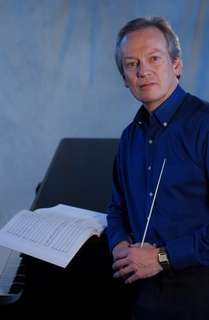|
Back
A Delightful Evening with Haydn and Mendelssohn Hong Kong
Hong Kong City Hall, Concert Hall
07/10/2009 -
Joseph Haydn: Symphony No. 37 in C major, Hob I:37 – Trumpet Concerto in E-flat major, Hob VIIe:1
Felix Mendelssohn-Bartholdy: Piano Concerto No.1 in G minor, Op. 25 – Symphony No. 4 in A major, Op. 90, “Italian”
James Thompson (Trumpet)
Hong Kong Sinfonietta, Howard Shelley (Conductor/Piano)

Howard Shelley (©Robbie Jack)
Unlike Mikhail Pletnev and Daniel Barenboim, who established their career as pianist-conductors, Howard Shelley’s achievement on conducting has been overshadowed by his remarkable pianism. He left the music aficionados memorable impression by his large amount of highly acclaimed recordings with Chandos and Hyperion, including Rachmaninov’s complete piano music and concertos, Mozart’s concertos, and some rarely performed piano repertoires such as music by Hummel, Tippett, and Vaughan Williams. On Friday evening, this British pianist, who will turn 60 by the coming February, displayed his energetic spirit and all-rounded musical abilities by standing on the conducting podium and sitting in front of the piano.
The concert opened with Mr. Shelley conducting Haydn’s 37th Symphony. It was rendered with refined articulation, the Sinfonietta’s chamber-scale intimacy, and Mr. Shelley’s trademark British elegance, reminding us of his elegant and polished recordings of Mozart’s piano concertos with the London Mozart Players. He captured the music’s every vestige of light and shade, delivering them with marvelously refined details, even in the vivacious Finale.
After that, Mr. Shelley sat on the piano chair with his back facing the audience, conducting Mendelssohn’s Piano Concerto No. 1 from the keyboard. Although he had a superb familiarity and understanding of the work, and his command on the orchestra and his instrument was magnificent, this kind of “Classical” setting did not seem so appropriate for the modern concert hall. The price he paid was an unbalanced acoustics, with some of the piano themes buried amidst the orchestral tutti. Nonetheless, he was capable of conducting with precise cues (by his free hand, eye-contact, and head-nodding) while playing on the piano with aplomb. Where many pianists falsely underlined the profundity and rumination of this G minor Concerto, Mr. Shelley brought to life Mendelssohn’s youthful vitality and puerile vivacity. It was tellingly exemplified in the Presto third movement, where the breath taking final coda was rendered with blistering pace and utmost dexterity. The songs-without-words second movement was also naturally sung by Mr. Shelley’s lucid voice and broadened melodic arc. I would perhaps have welcomed a more expressive phrasings from the orchestra to interplay with the soloist’s rapt expressivity.
After the intermission, Mr. Shelley transformed himself as a conductor again, but this time, accompanying James Thompson in Haydn’s famous Trumpet Concerto. Like the Symphony in the first half, this was a finely articulated, and elegantly rendered reading. Soloist Mr. Thompson played with a spectrum of colors, from horn-like tenderness in the slow movement, to glinting brightness in the outer movements. But his domineering intonation somehow sacrificed the balance between the solo and the orchestra, leaving the Sinfonietta’s chamber-scale tone under shades of grey.
To commemorate the 200th anniversary of Haydn’s death and Mendelssohn’s birth, the concert embraced two works by each composer. Mr. Shelley chose Mendelssohn’s Symphony No. 4 as the finale of the evening. Both the First Piano Concerto in the first half, and this “Italian” Symphony were composed during Mendelssohn’s early 20s. Once again, Mr. Shelley and the Hong Kong Sinfonietta’s reading was an absolute delight, brimming with exuberantly compulsive drive and thoughtfully weaved filigrees. There was careful awareness to the architecture of the artwork, convincingly exemplified by the breathless cohesions in each movement, without slack for any instant. The joyous coda in the first movement, for instance, sounded like an inevitable consequence of what had happened before. But this chamber-sized orchestra’s intimate intonation was a little too quiescent for the musics glorious fanfare in the first and last movements.
Hong Kong Sinfonietta’s Website
Danny Kim-Nam Hui
|